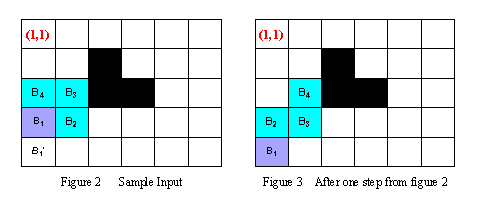poj1324 Holedox Moving
| Time Limit: 5000MS | Memory Limit: 65536K | |
| Total Submissions: 16980 | Accepted: 4039 |
Description
Holedox is a special snake, but its body is not very long. Its lair is like a maze and can be imagined as a rectangle with n*m squares. Each square is either a stone or a vacant place, and only vacant places allow Holedox to move in. Using ordered pair of row and column number of the lair, the square of exit located at (1,1).
Holedox's body, whose length is L, can be represented block by block. And let B1(r1,c1) B2(r2,c2) .. BL(rL,cL) denote its L length body, where Bi is adjacent to Bi+1 in the lair for 1 <= i <=L-1, and B1 is its head, BL is its tail.
To move in the lair, Holedox chooses an adjacent vacant square of its head, which is neither a stone nor occupied by its body. Then it moves the head into the vacant square, and at the same time, each other block of its body is moved into the square occupied by the corresponding previous block.
For example, in the Figure 2, at the beginning the body of Holedox can be represented as B1(4,1) B2(4,2) B3(3,2)B4(3,1). During the next step, observing that B1'(5,1) is the only square that the head can be moved into, Holedox moves its head into B1'(5,1), then moves B2 into B1, B3 into B2, and B4 into B3. Thus after one step, the body of Holedox locates in B1(5,1)B2(4,1)B3(4,2) B4(3,2) (see the Figure 3).
Given the map of the lair and the original location of each block of Holedox's body, your task is to write a program to tell the minimal number of steps that Holedox has to take to move its head to reach the square of exit (1,1). 
Input
The input is terminated by a line with three zeros.
Note: Bi is always adjacent to Bi+1 (1<=i<=L-1) and exit square (1,1) will never be a stone.
Output
Sample Input
5 6 4
4 1
4 2
3 2
3 1
3
2 3
3 3
3 4 4 4 4
2 3
1 3
1 4
2 4
4 2 1
2 2
3 4
4 2 0 0 0
Sample Output
Case 1: 9
Case 2: -1
Hint
Source
#include <cstdio>
#include <queue>
#include <cstring>
#include <iostream>
#include <algorithm> using namespace std; int n, m, l,tot = ,a[][];
int vis[][][ << ],k;
int d[][] = {
-,,-,
,-,,
-,,-
}; int dx[] = { ,-,, }, dy[] = { ,,,- }; struct node
{
int x[], y[], cnt;
}; bool check(int x, int y, node u)
{
for (int i = ; i <= l; i++)
if (x == u.x[i] && y == u.y[i])
return false;
return true;
} int bfs(node x)
{
queue<node> q;
q.push(x);
while (!q.empty())
{
node u = q.front();
q.pop();
if (u.x[] == && u.y[] == )
return u.cnt;
for (int i = ; i < ; i++)
{
node v;
int tx = u.x[] + dx[i], ty = u.y[] + dy[i];
if (tx < || tx > n || ty < || ty > m || a[tx][ty])
continue;
if (!check(tx, ty, u))
continue;
u.x[] = tx, u.y[] = ty;
int zhuangtai = ;
for (int j = l; j >= ; j--)
{
v.x[j] = u.x[j - ];
v.y[j] = u.y[j - ];
if (j != l)
{
int temp = d[v.x[j] - v.x[j + ] + ][v.y[j] - v.y[j + ] + ];
zhuangtai |= (temp << ( - j * ));
}
}
if (vis[tx][ty][zhuangtai] == tot)
continue;
vis[tx][ty][zhuangtai] = tot;
v.cnt = u.cnt + ;
q.push(v);
}
}
return -;
} int main()
{
while (scanf("%d%d%d", &n, &m, &l) == )
{
memset(a, , sizeof(a));
int temp = ,tx,ty;
node init;
scanf("%d%d", &init.x[], &init.y[]);
for (int i = ; i <= l; i++)
{
scanf("%d%d", &init.x[i], &init.y[i]);
tx = init.x[i - ] - init.x[i] + ;
ty = init.y[i - ] - init.y[i] + ;
temp |= (d[tx][ty] << ( - (i - ) * ));
}
vis[init.x[]][init.y[]][temp] = tot;
scanf("%d", &k);
for (int i = ; i <= k; i++)
{
int aa, bb;
scanf("%d%d", &aa, &bb);
a[aa][bb] = ;
}
init.cnt = ;
printf("Case %d: %d\n", tot++, bfs(init));
} return ;
}
poj1324 Holedox Moving的更多相关文章
- poj 1324 Holedox Moving
poj 1324 Holedox Moving 题目地址: http://poj.org/problem?id=1324 题意: 给出一个矩阵中,一条贪吃蛇,占据L长度的格子, 另外有些格子是石头, ...
- POJ 1324 Holedox Moving (状压BFS)
POJ 1324 Holedox Moving (状压BFS) Time Limit: 5000MS Memory Limit: 65536K Total Submissions: 18091 Acc ...
- POJ 1324 Holedox Moving 搜索
题目地址: http://poj.org/problem?id=1324 优先队列---A*的估价函数不能为蛇头到(1,1)的距离,这样会出错. 看了discuss,有大神说这题A*的估价函数为BFS ...
- UVALive 2520 Holedox Moving(BFS+状态压缩)
这个题目在比赛的时候我们是没有做出来的,但是听到他们说进制哈希的时候,感觉真的是挺高端的,于是赛后开始补题,本着我的习惯在看题解之前自己再试着写一遍,我当时存储状态的方法是string + map,我 ...
- POJ - 1324 Holedox Moving (状态压缩+BFS/A*)
题目链接 有一个n*m(1<=n,m<=20)的网格图,图中有k堵墙和有一条长度为L(L<=8)的蛇,蛇在移动的过程中不能碰到自己的身体.求蛇移动到点(1,1)所需的最小步数. 显然 ...
- ACM/ICPC 之 BFS+状态压缩(POJ1324(ZOJ1361))
求一条蛇到(1,1)的最短路长,题目不简单,状态较多,需要考虑状态压缩,ZOJ的数据似乎比POj弱一些 POJ1324(ZOJ1361)-Holedox Moving 题意:一条已知初始状态的蛇,求其 ...
- HOJ题目分类
各种杂题,水题,模拟,包括简单数论. 1001 A+B 1002 A+B+C 1009 Fat Cat 1010 The Angle 1011 Unix ls 1012 Decoding Task 1 ...
- BFS广搜题目(转载)
BFS广搜题目有时间一个个做下来 2009-12-29 15:09 1574人阅读 评论(1) 收藏 举报 图形graphc优化存储游戏 有时间要去做做这些题目,所以从他人空间copy过来了,谢谢那位 ...
- poj 1324 状态压缩+bfs
http://poj.org/problem?id=1324 Holedox Moving Time Limit: 5000MS Memory Limit: 65536K Total Submis ...
随机推荐
- [学习总结] python语言学习总结 (一)
还是不多说话了.. 1.eval函数 用法:eval(expression, globals=None, locals=None) 解释:将字符串str当成有效的表达式来求值并返回计算结果. 就是可以 ...
- Xor Sum
6498: Xor Sum 时间限制: 1 Sec 内存限制: 128 MB提交: 27 解决: 13[提交][状态][讨论版][命题人:admin] 题目描述 You are given a p ...
- Java制作桌面弹球下载版 使用如鹏游戏引擎制作 包含2个精灵球同时弹动
package com.swift; import com.rupeng.game.GameCore; public class DesktopBouncingBall implements Runn ...
- HTTP无状态协议和session原理(access_token原理)
无状态协议是指协议对务处理没有记忆能力.缺少状态意味着如果后续处理需要前面的信息,则它必须重传,这样可能导致每次连接传送的数据量增大.另一方面,在服务器不需要先前信息时它的应答就较快. Http协议不 ...
- js函数式编程(一)-纯函数
我将写的第一个主题是js的函数式编程,这一系列都是mostly adequate guide这本书的读书总结.原书在gitbook上,有中文版.由于原作者性格活泼,书中夹杂很多俚语,并且行文洒脱.中文 ...
- LNMP的环境搭建
新装的Linux 机器,还没有来得及安装网站环境,这篇文章就是记录一下自己安装LNMP的一般步骤. 之前在Laravel视频中看过这段的讲解,后来也试着安装过,基本的命令不算是熟练掌握,所以还要看看之 ...
- C语言中的32个关键字
C语言中的32个关键字 数据类型关键字(12个) (1) char:声明字符型变量或函数 (2) double:声明双精度变量或函数 (3) enum:声明美剧类型 (4) ...
- PHP安装Xcache扩展
简述 XCache 是一个又快又稳定的 PHP opcode 缓存器. 经过良好的测试并在大流量/高负载的生产机器上稳定运行. 经过(在 linux 上)测试并支持所有现行 PHP 分支的最新发布 ...
- python向上取整 向下取整
向上取整 ceil() 函数返回数字的向上取整整数,就是返回大于等于变量的最近的整数. ceil()是不能直接访问的,需要导入 math 模块. import math math.ceil( x ) ...
- 03 Django视图
功能 接受Web请求HttpRequest,进行逻辑处理,与 M 和 T 进行交互,返回 Web 响应 HttpResponse 给请求者 示例项目的创建 创建项目 test3 django-admi ...
